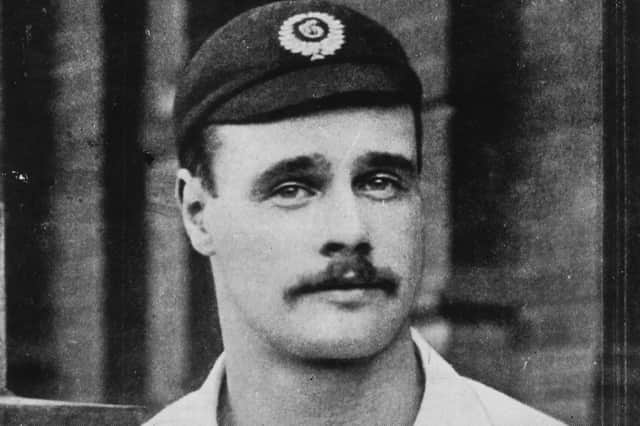How long before 'The Croucher' bows down to Harry Brook and England's 'Bazball' brigade?


Between 1894 and 1914, the so-called “golden age” of cricket, Jessop captivated crowds with his big-hitting batting and brilliant fast bowling, complemented by wonderful fielding ahead of its time.
As the great Jack Hobbs observed, Jessop “drew the crowds even more than Bradman, and made me glad that I was not a bowler”.
Advertisement
Hide AdAdvertisement
Hide AdWhen he died in 1955, aged 80, Wisden called Jessop “the most remarkable hitter cricket has ever produced”, adding that “although only 5ft 7ins in height, he bent low as he shaped to play, a method which earned him the sobriquet of ‘The Croucher’”.


If ‘The Croucher’ supposed that his fame would die out with him, over 100 years now since he bestrode that golden age, he would no doubt be surprised to find that it still crops up pretty much every time that England play a Test match these days.
His record for the fastest Test hundred for England - a 76-ball effort against Australia at the Oval in 1902 (the sports editor remembers it as though it was yesterday) - seems to come under threat game after game and yet still towers proudly after all these years, serving as a monument to Jessop’s power and skill.
Had he been able to conceive of such things as mobile phones and Twitter, let alone that people of the future would say things like ‘whatsapp’ as well as ‘what’s up?’, Jessop would no doubt be just as startled to find that #jessopwatch is even a thing on social media.
Advertisement
Hide AdAdvertisement
Hide AdIndeed, in the early hours of Wednesday, it was out in force again as, first, Ben Duckett and then Yorkshire’s Harry Brook flirted with a 121-year record which, rather like the musician Sir Elton John, is somehow still standing after all this time.
Duckett had faced only 68 balls when he fell for 84 on the opening day of the first Test against New Zealand in Mount Maunganui, and Brook had been up in Jessop territory himself prior to his dismissal for the top score of 89 from 81 deliveries as England totalled 325-9 after being sent into bat, the hosts teetering on 37-3 at stumps.
It was the third time in his fledgling Test career that Brook had sent a collective tremor through the Jessop family tree, having reached a hundred off 80 balls in the first innings of the first Test against Pakistan in Rawalpindi in December, followed by 87 off 65 balls in the second innings.
Zak Crawley, who reached a hundred off 86 balls in the same game, had not been far from taking down Jessop himself, while Jonny Bairstow came agonisingly close to usurping ‘The Croucher’ at Trent Bridge last summer when he reached a century against New Zealand off 77 balls, just one fewer than Jessop had required. A case of Brian Close but no cigar...
Advertisement
Hide AdAdvertisement
Hide AdBrook, 23, was the standout performer again on Wednesday and, despite being just five games into his Test career, already looks perhaps the team’s best player, on current form anyway.
After three hundreds in as many Tests in Pakistan, where he helped England to a 3-0 triumph, Brook so nearly became only the second England batsman after Ken Barrington to score four hundreds in successive Tests, a feat Barrington achieved twice in the 1960s.
But for an unfortunate dismissal at the hands of Neil Wagner, his new Yorkshire team-mate, Brook would surely have been raising his bat to the crowds again.
However, he got an inside-edge to a short ball that went into the stumps via his backside and the ground, his disappointed if phlegmatic reaction indicative of a player who seemingly expects, rather than hopes, to score a hundred.
Advertisement
Hide AdAdvertisement
Hide AdOnly Vinod Kambli (673), Conrad Hunte (577) and Javed Miandad (573) have scored more than Brook’s 569 runs in his first seven Test innings, a remarkable entry into cricket’s top level.
Brook has simply continued the form that he showed for Yorkshire last season, form based on a full array of strokes and a technically solid defence.
There are times when he appears to be toying with bowlers in the best traditions of such as Vivian Richards and Kevin Pietersen. A straight six off Tim Southee, the New Zealand captain, was gloriously dismissive.
As the historian HS Altham said of Jessop back in the day, “no cricketer that has ever lived hit the ball so often, so fast and with such a bewildering variety of strokes”, so contemporary chroniclers might soon be bestowing similar praise on the shoulders of Brook.
Advertisement
Hide AdAdvertisement
Hide AdAnd as for that 76-ball record for the fastest England Test hundred, Jessop’s long run may not last much longer.
For ‘The Croucher’, great though he was, may soon be crouching lower to bow down to the member of the ‘Bazball’ brigade - perhaps the brilliant Brook - who must surely beat him in the end.